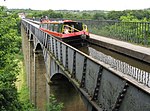Shropshire Union Canal

The Shropshire Union Canal, nicknamed the "Shroppie", is a navigable canal in England. The Llangollen and Montgomery canals are the modern names of branches of the Shropshire Union (SU) system and lie partially in Wales. The canal lies in the counties of Staffordshire, Shropshire and Cheshire in the north-west English Midlands. It links the canal system of the West Midlands, at Wolverhampton, with the River Mersey and Manchester Ship Canal at Ellesmere Port, Cheshire, 66 miles (106 km) distant. The "SU main line" runs southeast from Ellesmere Port on the River Mersey to the Staffordshire and Worcestershire Canal at Autherley Junction in Wolverhampton. Other links are to the Llangollen Canal (at Hurleston Junction), the Middlewich Branch (at Barbridge Junction), which itself connects via the Wardle Canal with the Trent and Mersey Canal, and the River Dee (in Chester). With two connections to the Trent and Mersey (via the Middlewich Branch and the Staffordshire and Worcestershire Canal) the SU is part of an important circular and rural holiday route called the Four Counties Ring. The SU main line was the last trunk narrow canal route to be built in England. It was not completed until 1835 and was the last major civil engineering accomplishment of Thomas Telford. The name "Shropshire Union" comes from the amalgamation of the various component companies (Ellesmere Canal, Birmingham and Liverpool Junction Canal, Montgomeryshire Canal) that came together to form the Shropshire Union Railways and Canal Company. The main line between Nantwich and Autherley Junction was almost built as a railway although eventually it was decided to construct it as a waterway.
Excerpt from the Wikipedia article Shropshire Union Canal (License: CC BY-SA 3.0, Authors, Images).Shropshire Union Canal
Oil Sites Road,
Geographical coordinates (GPS) Address Nearby Places Show on map
Geographical coordinates (GPS)
| Latitude | Longitude |
|---|---|
| N 53.283333333333 ° | E -2.8833333333333 ° |
Address
Oil Sites Road
CH65 4FF , Wolverham
England, United Kingdom
Open on Google Maps










